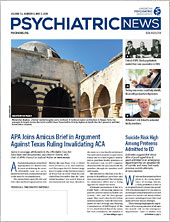While much attention has been given to the rising prevalence of teenage suicide, a study published in March in Hospital Pediatrics found that nearly 30% of preteens (aged 10 to 12) taken to an emergency department (ED) screened positive for suicide risk. Many of these preteens—including 10-year-olds—had made previous suicide attempts.
“These findings highlight the importance of screening patients of all ages for suicide risk in the emergency department,” said co-author Lisa Horowitz, Ph.D., M.P.H., a staff scientist at the National Institute of Mental Health (NIMH).
Horowitz and her colleagues assessed data from a large suicide-screening study of youth aged 10 to 21 who were admitted to one of three urban pediatric hospitals (Children’s National in Washington, D.C., Boston Children’s Hospital, and Nationwide Children’s Hospital in Columbus, Ohio) between 2008 and 2011. A major aim of this study was to test the reliability of the Ask Suicide-Screening Questions (ASQ), a four-item screening tool that busy hospital staff could administer in about 20 seconds. However, it also provided an opportunity to calculate suicide risk in preteens, who are understudied in suicide research.
Of the 524 study participants, 79 were between the ages of 10 and 12. Forty-two of the 79 preteens were admitted to the ED for a medical emergency, such as a back injury or chest pain, and 37 were admitted for a psychiatric emergency such as depression or violent behavior.
In total, 29% of preteens screened positive for suicide risk on the ASQ and/or the longer Suicidal Ideation Questionnaire-Junior. This included 54% of preteens (20 of 37) who had a psychiatric emergency and 7% (3 of 42) of those with a medical emergency.
Fourteen of the 79 preteens—including seven 10-year-olds—reported a previous suicide attempt. “It’s possible many of these attempts were not life-threatening, but in these kids’ minds, the attempts were lethal, and that is the important fact,” Horowitz told Psychiatric News.
Horowitz explained that the Joint Commission—a nonprofit organization that accredits U.S. hospitals—has recently revised its National Patient Safety Goals (NPSG) to include a recommendation that all patients in a hospital setting be screened for suicide regardless of their medical condition. The previous NPSG limited the suicide-screening recommendation to patients who presented with a behavioral issue.
While Horowitz thinks including nonpsychiatric emergencies in a suicide-screening protocol is an important step forward—and one supported by these research data—the NPSG does not yet specify a minimum patient age for suicide screening. Horowitz, who also serves as an attending pediatric psychologist at the National Institutes of Health’s Clinical Center, hopes these results will raise awareness that it may never be too early to consider a suicide screen.
“Currently, hospital staff typically start [suicide] screening on patients 13 and older, since that’s believed to be when suicide risk elevates,” she said. “I would suggest emergency departments screen all children aged 10 and above, or 8 and above if they are admitted with a behavioral problem.” ■
“The Importance of Screening Preteens for Suicide Risk in the Emergency Department” can be accessed
here.

